How to spot fake pop-ups like "Your Apple ID Was Recently Used At APPLE STORE"
Phishing/ScamAlso Known As: Your Apple ID Was Recently Used At APPLE STORE scam
Get free scan and check if your device is infected.
Remove it nowTo use full-featured product, you have to purchase a license for Combo Cleaner. Seven days free trial available. Combo Cleaner is owned and operated by RCS LT, the parent company of PCRisk.com.
What kind of scam is "Your Apple ID Was Recently Used At APPLE STORE"?
Our analysis shows that it is a technical support scam involving a fake pop-up alert and other deceptive elements. Its purpose is to trick unsuspecting individuals into calling a fake support number. The scammers behind it aim to steal money, information, or deliver malware.

"Your Apple ID Was Recently Used At APPLE STORE" scam overview
This scam involves a fraudulent message claiming that an Apple ID was used for a $149.99 transaction at the Apple Store via Apple Pay. The message states that the transaction has been placed on hold for security reasons and urges the recipient to call a provided phone number (1-844-737-3342) to "freeze" their account.
The goal of the scam is to trick victims into contacting the scammers. Once victims call the provided number, the attackers typically pose as Apple support representatives and attempt to extract sensitive information, such as Apple ID credentials, passwords, credit card numbers, or other personal data.
In some cases, they may also instruct victims to install remote access software, giving the scammers control over the device. Using this software, fraudsters can access sensitive information, infect computers, make unauthorized purchases, manipulate files, and more. This can lead to financial loss, identity theft, security compromise, and other issues.
A couple of examples of scams where cybercriminals use legitimate remote administration tools to access computers are UltraViewer and TeamViewer scams.
| Name | Your Apple ID Was Recently Used At APPLE STORE scam |
| Threat Type | Phishing, Scam, Mac malware, Mac virus |
| Fake Claim | Apple ID was used for a $149.99 transaction |
| Related Domain | twqiuwe.z30.web.core.windows[.]net |
| Detection Names (twqiuwe.z30.web.core.windows[.]net) | CyRadar (Phishing), ESET (Phishing), Google Safebrowsing (Phishing), Lionic (Phishing), Full List (VirusTotal) |
| Serving IP Address | 20.60.10.36 |
| Fake Tech Support Number | 1-844-737-3342, +1-844-737-3342 |
| Symptoms | Your Mac becomes slower than normal, you see unwanted pop-up ads, you are redirected to dubious websites. |
| Distribution methods | Deceptive pop-up ads, free software installers (bundling), torrent file downloads. |
| Damage | Internet browser tracking (potential privacy issues), display of unwanted ads, redirects to dubious websites, loss of private information. |
| Malware Removal (Windows) |
To eliminate possible malware infections, scan your computer with legitimate antivirus software. Our security researchers recommend using Combo Cleaner. Download Combo CleanerTo use full-featured product, you have to purchase a license for Combo Cleaner. 7 days free trial available. Combo Cleaner is owned and operated by RCS LT, the parent company of PCRisk.com. |
Conclusion
Overall, this scam is designed to trick users into divulging personal information, transferring money to scammers, or granting access to their devices. Users should be cautious of unexpected messages, avoid calling unknown numbers, and never install software or provide credentials while visiting suspicious pages.
Examples of similar scams are "Apple Security Found Some Infected Files", "Mac OS Firewall-Alert", and "Virus Alert 027341".
How did I open a scam website?
Most users land on scam websites unintentionally. These fraudulent pages are often spread through rogue advertising networks used by torrent sites, pirated streaming platforms, adult content websites, and similar sites. Users can also encounter these sites via misleading pop-ups, fake download buttons, or deceptive ads on untrustworthy pages.
Clicking links in deceptive emails or other suspicious messages (e.g., notifications from unreliable pages) can also lead to scams. In some cases, adware installed on the system may expose users to scam websites.
How to avoid visiting scam websites?
Do not trust ads, click buttons, or links on untrustworthy websites, and always decline notification requests from suspicious pages. Keep your operating system and applications up to date, and secure your device with reliable security software. Download software from official sources or reputable app stores.
Be cautious with unexpected or unrelated emails and messages, and never open links or attachments found in them. If your computer is already infected, we recommend running a scan with Combo Cleaner Antivirus for Windows to automatically eliminate all threats.
Appearance of "Your Apple ID Was Recently Used At APPLE STORE" scam (GIF):
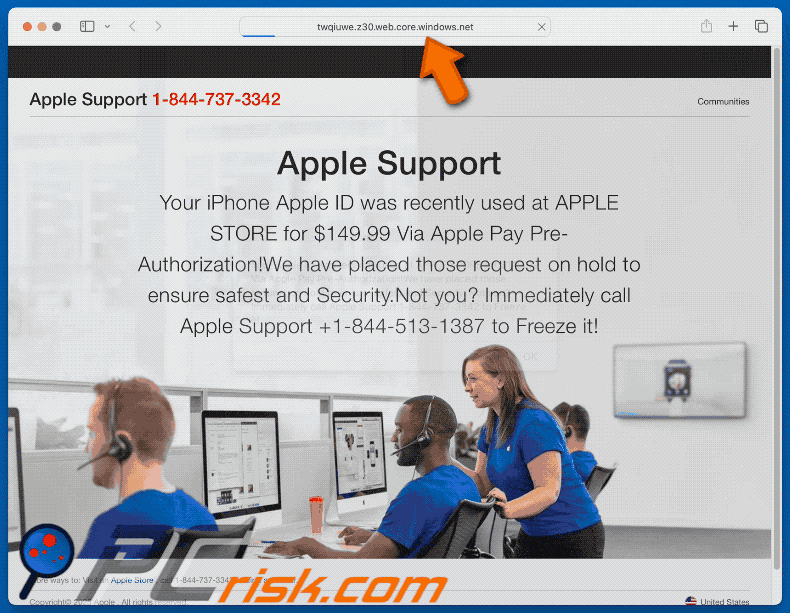
Text in the fake message:
Your Apple ID was recently used at APPLE STORE for $149.99 Via Apple Pay Pre-Authorization!We have placed those request on hold to ensure safest and Security. Not you? Immediately call Apple Support 1-844-737-3342 to Freeze it!.
Instant automatic malware removal:
Manual threat removal might be a lengthy and complicated process that requires advanced IT skills. Combo Cleaner is a professional automatic malware removal tool that is recommended to get rid of malware. Download it by clicking the button below:
DOWNLOAD Combo CleanerBy downloading any software listed on this website you agree to our Privacy Policy and Terms of Use. To use full-featured product, you have to purchase a license for Combo Cleaner. 7 days free trial available. Combo Cleaner is owned and operated by RCS LT, the parent company of PCRisk.com.
Quick menu:
- What is "Your Apple ID Was Recently Used At APPLE STORE"?
- STEP 1. Remove PUA related files and folders from OSX.
- STEP 2. Remove rogue extensions from Safari.
- STEP 3. Remove rogue add-ons from Google Chrome.
- STEP 4. Remove potentially unwanted plug-ins from Mozilla Firefox.
Video showing how to remove adware and browser hijackers from a Mac computer:
Potentially unwanted applications removal:
Remove potentially unwanted applications from your "Applications" folder:
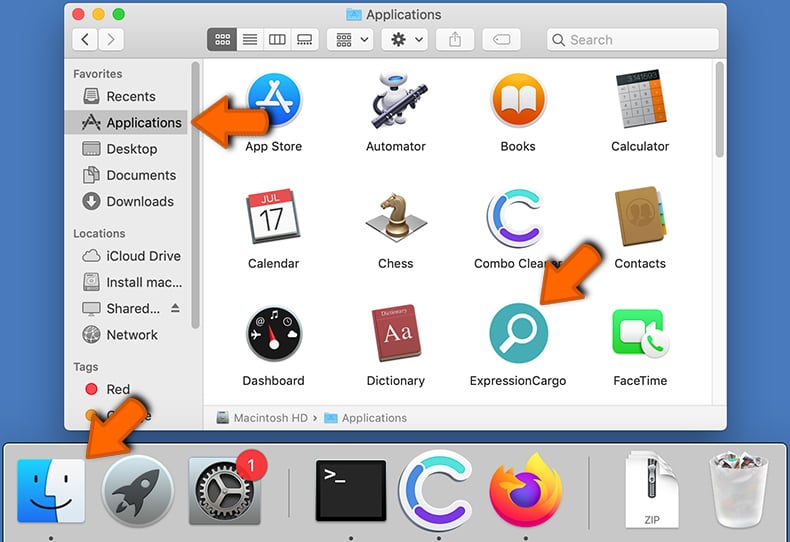
Click the Finder icon. In the Finder window, select "Applications". In the applications folder, look for "MPlayerX","NicePlayer", or other suspicious applications and drag them to the Trash. After removing the potentially unwanted application(s) that cause online ads, scan your Mac for any remaining unwanted components.
DOWNLOAD remover for malware infections
Combo Cleaner checks if your computer is infected with malware. To use full-featured product, you have to purchase a license for Combo Cleaner. 7 days free trial available. Combo Cleaner is owned and operated by RCS LT, the parent company of PCRisk.com.
Remove adware-related files and folders
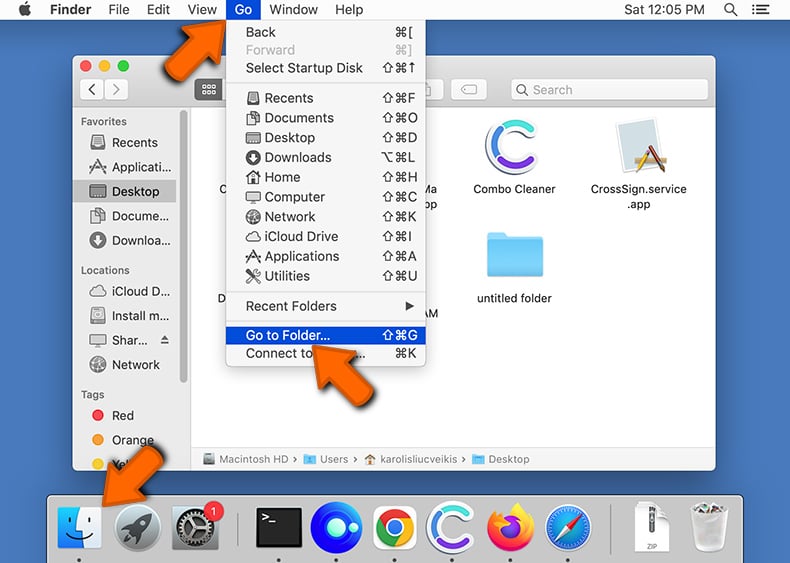
Click the Finder icon, from the menu bar. Choose Go, and click Go to Folder...
 Check for adware generated files in the /Library/LaunchAgents/ folder:
Check for adware generated files in the /Library/LaunchAgents/ folder:
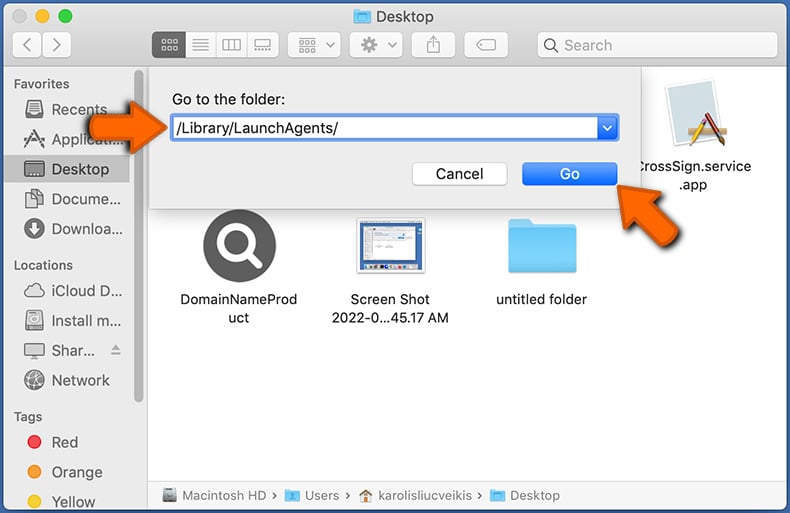
In the Go to Folder... bar, type: /Library/LaunchAgents/

In the "LaunchAgents" folder, look for any recently-added suspicious files and move them to the Trash. Examples of files generated by adware - "installmac.AppRemoval.plist", "myppes.download.plist", "mykotlerino.ltvbit.plist", "kuklorest.update.plist", etc. Adware commonly installs several files with the exact same string.
 Check for adware generated files in the ~/Library/Application Support/ folder:
Check for adware generated files in the ~/Library/Application Support/ folder:

In the Go to Folder... bar, type: ~/Library/Application Support/
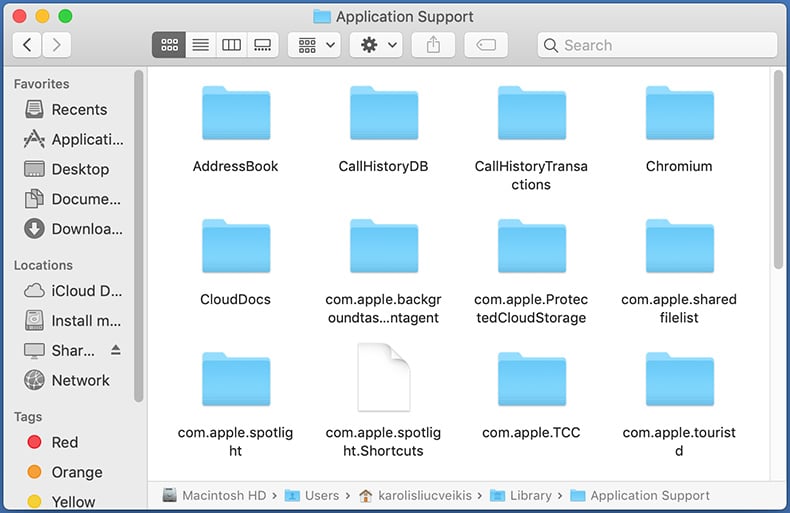
In the "Application Support" folder, look for any recently-added suspicious folders. For example, "MplayerX" or "NicePlayer", and move these folders to the Trash.
 Check for adware generated files in the ~/Library/LaunchAgents/ folder:
Check for adware generated files in the ~/Library/LaunchAgents/ folder:
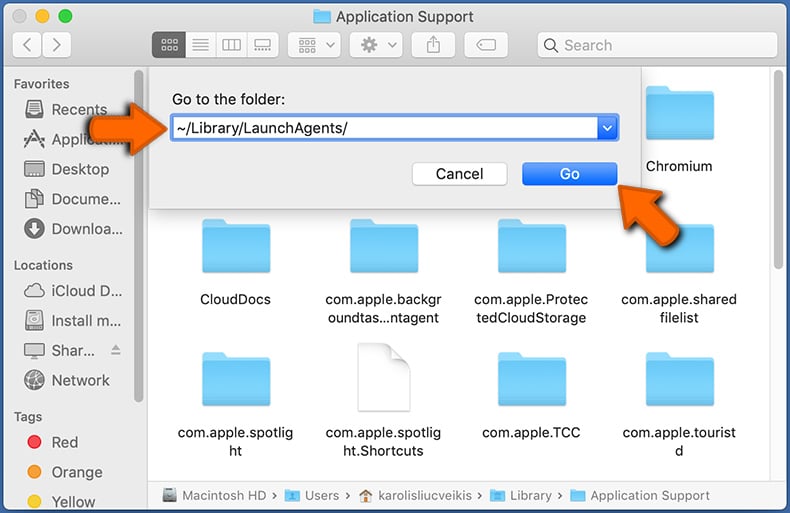
In the Go to Folder... bar, type: ~/Library/LaunchAgents/

In the "LaunchAgents" folder, look for any recently-added suspicious files and move them to the Trash. Examples of files generated by adware - "installmac.AppRemoval.plist", "myppes.download.plist", "mykotlerino.ltvbit.plist", "kuklorest.update.plist", etc. Adware commonly installs several files with the exact same string.
 Check for adware generated files in the /Library/LaunchDaemons/ folder:
Check for adware generated files in the /Library/LaunchDaemons/ folder:
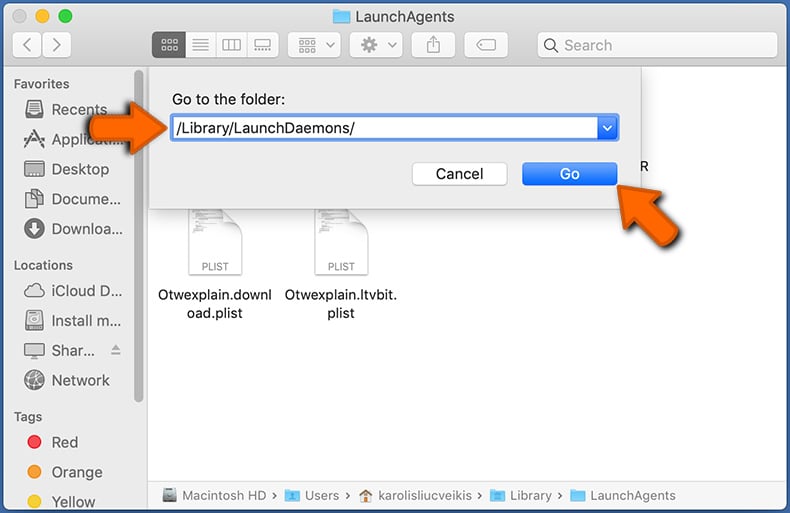
In the "Go to Folder..." bar, type: /Library/LaunchDaemons/

In the "LaunchDaemons" folder, look for recently-added suspicious files. For example "com.aoudad.net-preferences.plist", "com.myppes.net-preferences.plist", "com.kuklorest.net-preferences.plist", "com.avickUpd.plist", etc., and move them to the Trash.
 Scan your Mac with Combo Cleaner:
Scan your Mac with Combo Cleaner:
If you have followed all the steps correctly, your Mac should be clean of infections. To ensure your system is not infected, run a scan with Combo Cleaner Antivirus. Download it HERE. After downloading the file, double click combocleaner.dmg installer. In the opened window, drag and drop the Combo Cleaner icon on top of the Applications icon. Now open your launchpad and click on the Combo Cleaner icon. Wait until Combo Cleaner updates its virus definition database and click the "Start Combo Scan" button.
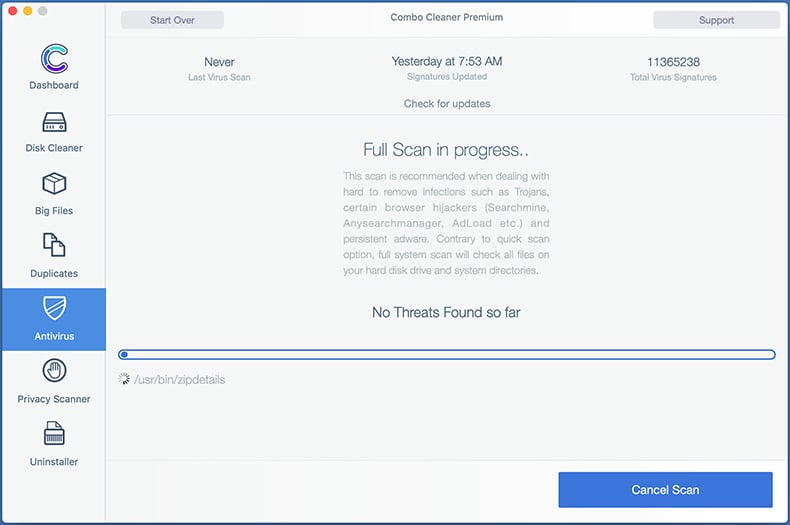
Combo Cleaner will scan your Mac for malware infections. If the antivirus scan displays "no threats found" - this means that you can continue with the removal guide; otherwise, it's recommended to remove any found infections before continuing.
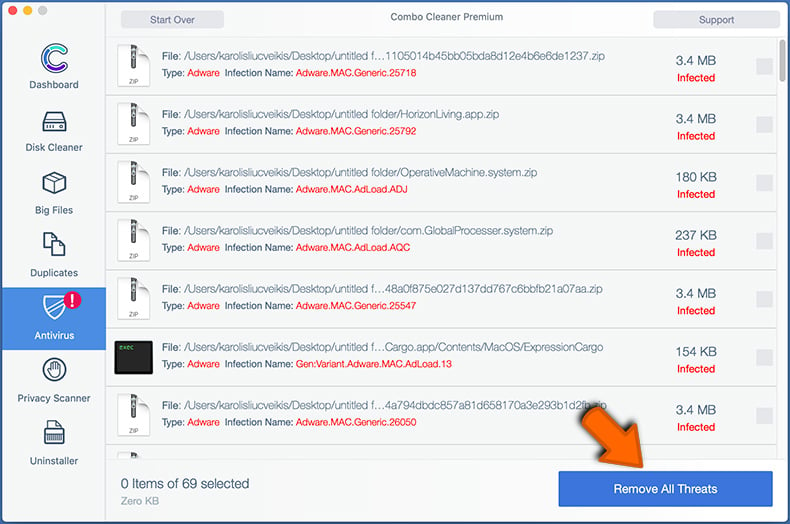
After removing files and folders generated by the adware, continue to remove rogue extensions from your Internet browsers.
Remove malicious extensions from Internet browsers
 Remove malicious Safari extensions:
Remove malicious Safari extensions:
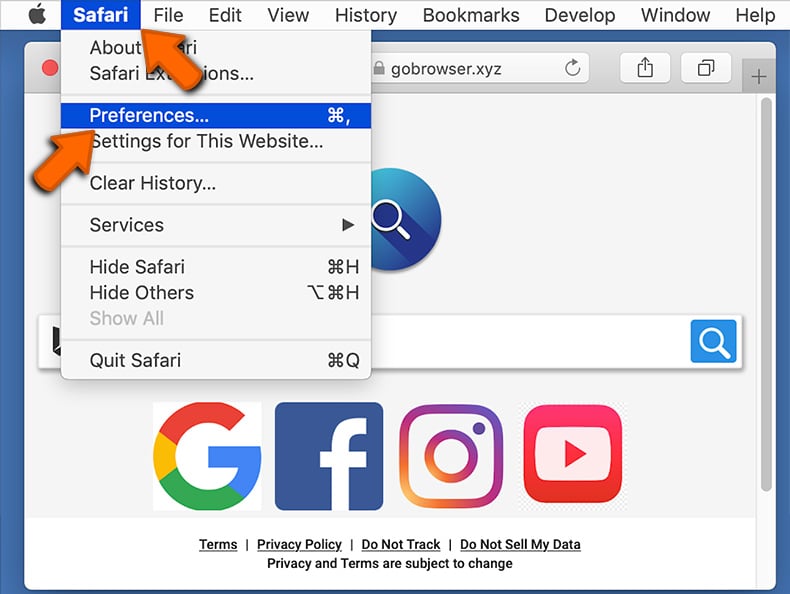
Open the Safari browser, from the menu bar, select "Safari" and click "Preferences...".

In the preferences window, select "Extensions" and look for any recently-installed suspicious extensions. When located, click the "Uninstall" button next to it/them. Note that you can safely uninstall all extensions from your Safari browser - none are crucial for regular browser operation.
- If you continue to have problems with browser redirects and unwanted advertisements - Reset Safari.
 Remove malicious extensions from Google Chrome:
Remove malicious extensions from Google Chrome:

Click the Chrome menu icon ![]() (at the top right corner of Google Chrome), select "More Tools" and click "Extensions". Locate all recently-installed suspicious extensions, select these entries and click "Remove".
(at the top right corner of Google Chrome), select "More Tools" and click "Extensions". Locate all recently-installed suspicious extensions, select these entries and click "Remove".

- If you continue to have problems with browser redirects and unwanted advertisements - Reset Google Chrome.
 Remove malicious extensions from Mozilla Firefox:
Remove malicious extensions from Mozilla Firefox:
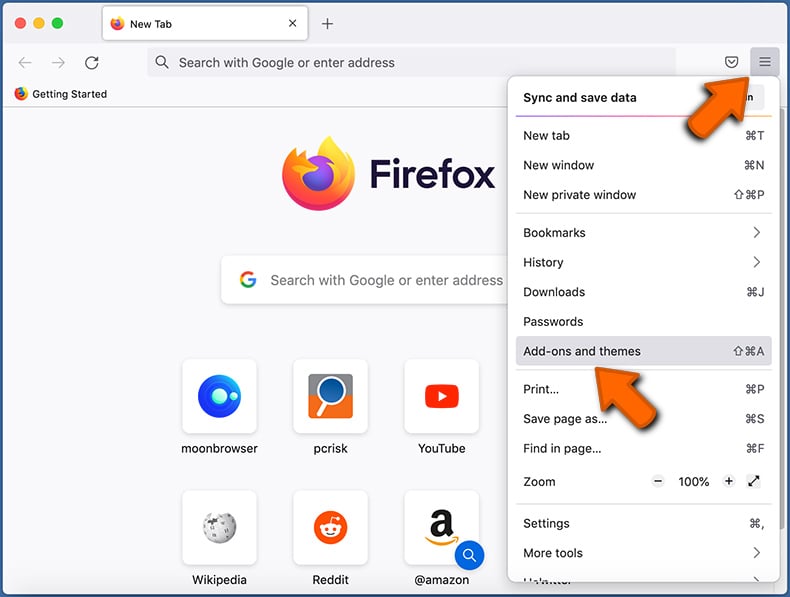
Click the Firefox menu ![]() (at the top right corner of the main window) and select "Add-ons and themes". Click "Extensions", in the opened window locate all recently-installed suspicious extensions, click on the three dots and then click "Remove".
(at the top right corner of the main window) and select "Add-ons and themes". Click "Extensions", in the opened window locate all recently-installed suspicious extensions, click on the three dots and then click "Remove".
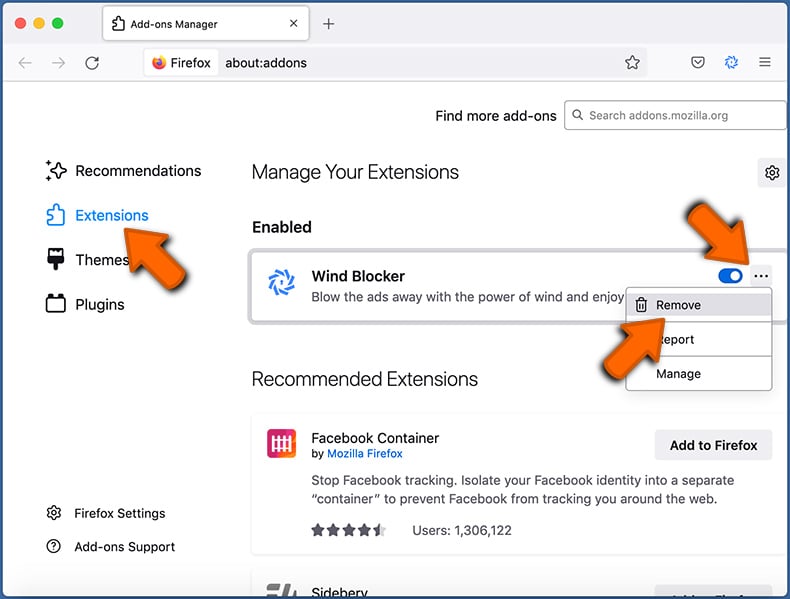
- If you continue to have problems with browser redirects and unwanted advertisements - Reset Mozilla Firefox.
Frequently Asked Questions (FAQ)
What is a pop-up scam?
This scam often involves a fake message (e.g., a system warning or a security alert) or multiple messages urging users to take immediate action.
What is the purpose of a pop-up scam?
Scammers behind these scams usually try to extract money, personal information, or obtain remote access to computers.
Why do I encounter fake pop-ups?
Most users visit scam websites unintentionally, often through rogue advertising networks on torrent, illegal streaming, or adult sites, misleading pop-ups, fake download buttons, or deceptive emails. Adware on the system and deceptive browser notifications can also redirect users to these fraudulent pages.
Will Combo Cleaner protect me from pop-up scams?
Combo Cleaner scans websites you visit and can identify malicious pages. Sites that deliver pop-up scams are included, so you will receive an immediate warning and access will be blocked.
Share:

Tomas Meskauskas
Expert security researcher, professional malware analyst
I am passionate about computer security and technology. I have an experience of over 10 years working in various companies related to computer technical issue solving and Internet security. I have been working as an author and editor for pcrisk.com since 2010. Follow me on Twitter and LinkedIn to stay informed about the latest online security threats.
PCrisk security portal is brought by a company RCS LT.
Joined forces of security researchers help educate computer users about the latest online security threats. More information about the company RCS LT.
Our malware removal guides are free. However, if you want to support us you can send us a donation.
DonatePCrisk security portal is brought by a company RCS LT.
Joined forces of security researchers help educate computer users about the latest online security threats. More information about the company RCS LT.
Our malware removal guides are free. However, if you want to support us you can send us a donation.
Donate
▼ Show Discussion